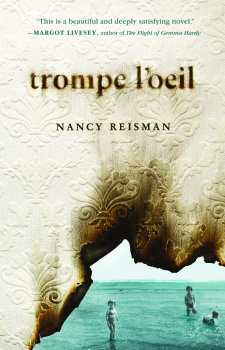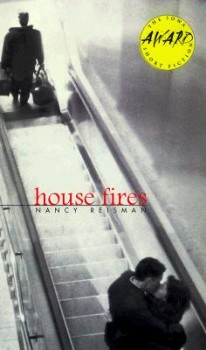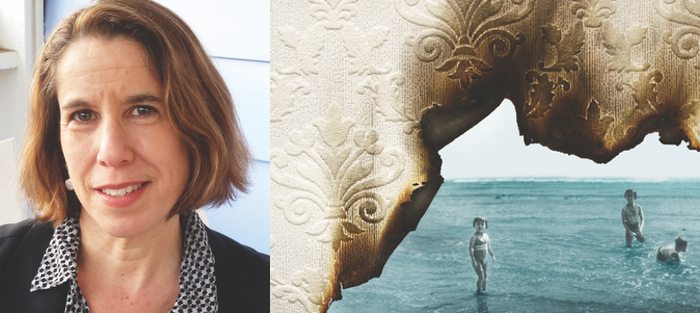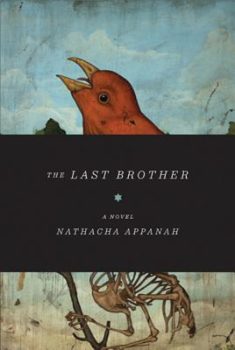I’ve been a fan of Nancy Reisman’s since we were fellows together at the Fine Arts Work Center in Provincetown, Massachusetts in 1997-98. I lived upstairs from her on Fishburn Court, and we would take breaks from our writing to walk down Commercial Street to the Post Office together. Her work impressed me from the beginning. In her beautifully written fiction, each character is drawn with incredible care, complicated and fully-rounded. She writes both gorgeously and with compassion. At that time she had finished her short story collection, House Fires, which would later win the Iowa Short Fiction Award, and was working on her debut novel, The First Desire, which would become A New York Times Notable Book when it was published in 2004. The novel, whose narrative follows a Jewish family in Buffalo, New York, over the course of several decades, would receive the Goldberg Award and rave reviews.
Her newest novel, Trompe l’Oeil, to be published by Tin House Books on May 12, takes us to a wholly different landscape, but the deep humanity with which the characters are drawn is clearly hers. In short, vivid chapters, we watch the Murphy family as they are first struck by tragedy on a trip to Rome and then as they attempt to carry on back home in Blue Rock on the Massachusetts coast. Alternating between points of view, Trompe l’Oeil examines both grief and transcendence. Throughout the book, interspersed descriptions of paintings (mainly Renaissance) and snapshot moments in Rome deepen our experience of their story.
It has been an honor to read this book in manuscript, and it is a pleasure to talk with Nancy now as it is about to appear in print. Trompe l’Oeil is breathtakingly beautiful and intensely felt, a novel of both tragedy and grace, a richly layered work by a deeply original writer at the top of her game.
Interview:
Carin Clevidence: Trompe l’Oeil explores the aftermath of a family tragedy. One of the most haunting aspects, for me, is the way we see the shock waves reverberating over the years, affecting characters who were not alive at the time of the actual accident. I’m interested to know more about what drew you to this story, and your thoughts on the shadow trauma can cast over a family? I’m interested also in the way people absorb the suffering of others, especially as children.
Nancy Reisman: Weirdly, I think I found myself drawn to the story both because I was haunted and astonished by how anyone navigates through and beyond those shock waves; and because, for me, this frame made meaningful exploration possible. I say this in retrospect. Initially I just had a persisting awareness of the character situation. I think that with luck, the inherited weave of history might also include resilience, beauty, and imaginative possibility. The larger question—the shadow or reverberations of trauma—is so vast, that, as a friend pointed out, we might be talking about all of human history. It’s complicated: how do you address something you experience as a shadow, a reverberation either without an identifiable source or rooted in a time preceding your own conscious life? It seems to me especially difficult—and, as you investigate in your fiction, profoundly difficult for children—to identify the effects as effects rather than perceiving them as laws or facts of nature, as “the way things are.”
Can you talk about the challenges of writing multiple points of view, shifting emphases, all while keeping the time frame and the characters’ relationships clear to the reader?
I often work by assemblage—in this case, writing moments, scenes, chapters as I considered a particular character or place or kind of encounter, regardless of where that piece might finally settle into the book. As I built more of the structure, I began to see what else I wanted to develop. So one set of challenges comes in on the level of each character’s points of view and character development: the characters evolved during the writing of the book, and with each character I found points of access and obstacles. I saw the character of Nora as my first and strongest anchor, and from there worked outward, and then re-visited and reinterpreted her.
Another set of challenges came with building that structure and balancing it, which for me required a lot of staring at the pieces. I tried to make this literal—colored paper with easy-to-move chapter titles on a bulletin board, a three-ring binder with the printed text and brightly colored section markers or time markers. Lots of reading and re-reading, trying to get a felt-sense of where juxtapositions and contrasts made sense, what needed development, staring at the transitions. I’ve been lucky to have wonderfully insightful, patient readers along the way. It seems to me that finding the balance as best I could was an odd meta-experience of the book—it was about finding ways to get perspective, to be able to see, and learning and re-learning how to tolerate the uncertainty.
Like The First Desire, this is a novel rich in characters and points of view, and follows the members of a large family over the course of years. The short, focused chapters—with titles like “House I,” “Rome,” “Blizzard,” “Dresses”—work beautifully to illuminate moments, images, relationships. How did the structure evolve?
 My initial drafts were exploratory, in some ways fragmented, in other ways sort of lumpy and awkwardly adolescent. They were my way of telling myself the family story and understanding the characters more deeply. They included the shifting points of view—I wanted that from the start. I’d used some short focused pieces in The First Desire, so the more character-based short chapters made sense to me.
My initial drafts were exploratory, in some ways fragmented, in other ways sort of lumpy and awkwardly adolescent. They were my way of telling myself the family story and understanding the characters more deeply. They included the shifting points of view—I wanted that from the start. I’d used some short focused pieces in The First Desire, so the more character-based short chapters made sense to me.
I had a chance to spend several weeks in Rome followed by time at an art colony where I met the multi-media artist and filmmaker Liss Platt. Considering Liss’s work—the particular way she was using repetition as a key and overt element in structuring projects, the way she brought together elements in her short personal film, You Can’t Get There From Here (which she describes as “a kinetic scrapbook”), her early work on her current film project, Dark Horse Candidate—helped me see structural possibilities I began to pursue in my own work. This came most readily with the ekphrastic writing and with the different views of the house over time. I was working with the material for the Rome pieces in the early part of the book from the start, though they took shape over time; some of the other short Rome pieces came in when I had found the structure I wanted.
Can you talk a little about the time this novel took? It seems to me that the richness and the balance you achieve between the different parts of the novel owe something to that. The writing is so assured, and the sections follow so naturally, it is tempting to think that you wrote it in the sequence we read it, though I know that’s not the case.
Liss’s film title, You Can’t Get There From Here—for long stretches that seemed to apply. This book took years to evolve, in part because the more complex and involved a piece, the longer it takes for me to discover what’s important and see it clearly. I also teach at a university, and I juggle teaching and family obligations with writing time, so I do most of my writing in summer. For a while I took a break from the novel and wrote stories. That gave me the satisfaction of finishing work even though the novel still seemed to be an unsolved puzzle. I think of that Rome trip and the time afterward as pivotal, because before then I had written a great deal, but hadn’t yet found the form I wanted. Once I’d found the form, I took the novel through many revisions. I’ve learned (and re-learned) that when I first believe a piece is done, in which I’ve probably completed the draft in which my goals are clear for readers to perceive, I probably have at least a dozen more revisions yet to go. While I wish I could speed the process, I know that this is the way I work.
I love the descriptions of specific works of art that are included throughout the book. You begin with an actual trompe l’oeil (“Prospettiva,” by Francesco Borromini) in which what appears to be a “long, high-ceilinged hall” is actually a “foreshortened stage,” and you describe “the unfurling space a deft false promise.” The other paintings are of Renaissance women, captured in moments of solitude, and stunningly described. Can you talk about how you came to include these works of art? At what point in the process did their inclusion occur to you? How did they inform the writing of the rest of the book?
 I’m so glad you respond to those descriptions. They’re important to the way I see the book, and they were really a pleasure to write. Years ago, my husband, Rick, and I had met a wonderful, exuberant writer from Madrid, Mercedes Cebrian, who was then at the Spanish Academy in Rome; she took us on a city tour that featured her favorite places—that was my introduction to the “Prospettiva.” I kept a postcard and revisited the “Prospettiva” on another trip; and it was on that later trip that I began to study the Magdalen paintings. I’d been visiting galleries and churches, dutifully admiring marvelously and some less marvelously painted biblical scenes and portraits, not really connecting with any of them. But Dominico Fetti’s “Penitent Magdalen” seemed to me another kind of painting, and I saw the image before I read the title. For me it was and is firstly a young woman, alone, thinking. In that same gallery hangs the radically different Caravaggio treatment. After that I began to look for certain images, in Rome and elsewhere, the Magdalens in particular.
I’m so glad you respond to those descriptions. They’re important to the way I see the book, and they were really a pleasure to write. Years ago, my husband, Rick, and I had met a wonderful, exuberant writer from Madrid, Mercedes Cebrian, who was then at the Spanish Academy in Rome; she took us on a city tour that featured her favorite places—that was my introduction to the “Prospettiva.” I kept a postcard and revisited the “Prospettiva” on another trip; and it was on that later trip that I began to study the Magdalen paintings. I’d been visiting galleries and churches, dutifully admiring marvelously and some less marvelously painted biblical scenes and portraits, not really connecting with any of them. But Dominico Fetti’s “Penitent Magdalen” seemed to me another kind of painting, and I saw the image before I read the title. For me it was and is firstly a young woman, alone, thinking. In that same gallery hangs the radically different Caravaggio treatment. After that I began to look for certain images, in Rome and elsewhere, the Magdalens in particular.
Following the trip, when I returned to the novel writing, I began to write the short pieces about the artworks. It made sense to me to include them, given that the Nora character has a longstanding interest in art and key moments of the book take place in Rome. I hoped to have a kind of gallery within the book, interludes that might in some way relate to the questions the book’s narrative raises, a different kind of encounter for readers. It became a way for me to bring up vexed questions and possibilities around representation. As I was writing them, they did become like puzzle pieces I moved around the manuscript, until over time I discovered where they seemed to work best.
You are a master of multiple points of view, and you move the reader effortlessly and convincingly between the different members of this family—Nora, worried about money; James, staggered by the loss of his job; Katy, in love for the first time. The book covers vast distances, geographic and emotional, but manages to feel intimate in relation to each character. Can you tell us about how you manage to achieve both the closeness and the perspective?
It’s lovely of you to say these things. There is always so much to learn. To the extent that these perspectives work—and I’m so glad that for you they do—it’s all fairly hard won, and like the novel as a whole, tempered by time. You and I have talked about finding optimal distance—both within the perspectives and representations in a book and for a writer as she approaches the material—and I played around with distance in different sections and in the novel as a whole. There is narration here I see as separate from the characters (though at times closely allied with one or another), and it took some experimentation to find the balance. Certain sections—for example, the numbered Murphys sections—pushed the writing toward a longer view. Along with the Rome and art sections, I hope they give the reader some necessary breathing room. Other moments stay very close to one or another character.
I’m interested in something you said about the power dynamics of narrative and about making space for the reader. Can you elaborate on that?
Sure. It’s important though not easy for me to articulate, as each question seems to raise other questions. Take, for a starting point, that a writer’s values—in this case mine—are integral to the work. You might say that’s the point—art as a way of seeing, fiction as a way of exploring a certain vision. We could talk about the different ways those values—or, maybe call it the subjective vision?—might become evident (or seem implicit) within the work: what is (and is not) represented and how, but also, importantly, form and style. In any case, it is a subjective vision.
So: how transparent or opaque is the work about its own subjectivity? For me, that’s where the issues of power and narration come in, and, by extension, issues of democracy. (Was it a James Wood piece about W.G. Sebald that discussed Sebald’s rejection of third-person narration given the carnage of the Second World War? I think so. That’s an extreme and it’s instructive: at the far end of that third-person spectrum, propaganda). As a reader, I love immersive storytelling, but I don’t want to absorb the values unquestioningly. So as I think about my own work, I want the writing to offer avenues for a reader to engage in conversation, to see the subjectivity, and to avert the potential for invisibility. Certain directions in narration seem to lend themselves to this conversation better than others. First-person announces a kind of subjectivity (though it may be more layered and nuanced than the character narrator herself). Cubist-influenced narration offers multiple and sometimes conflicting perspectives, in either first- or close-third, and seems to open up that kind of space. Speculation in the narration, the presence of doubt and questioning, also, I think makes a kind of space. The space is no small thing: how do we experience the dynamics of power in our own lives and the narratives of the self? What is the relationship between the ways we regularly experience and perceive different narratives and individual agency? These are the questions I find myself returning to.
And do you want to say anything about the theme of women in solitude, not just in this book but also in The First Desire and in your story collection, House Fires? I think we are taught from fairy tales onward to expect princes for our heroines. It’s a pleasure to see women in your fiction fully present in their solitude. I wonder if this in some ways relates to the rich and crowded family life that you also portray so vividly. There’s a moment toward the end of The First Desire where Goldie, accustomed to living alone, wakes up in her sister Sadie’s house:
In the morning she’s startled to hear footsteps in the hall, the water tap, murmuring voices close by; and then the sounds seem a kind of protective shield. They comfort her but already she remembers the intensities of family routines, the way one’s attention is pulled and refocused and pulled again.
You show the intensities of family routines so well in the house on Shore Road in Trompe l’Oeil, and also the ways that different women in the Murphy family seek solitude out. I’m thinking of Sara, of course, especially, but also of Nora and her postcard collection, her dreams of other possible lives. Can you talk a little about solitude and possibility? About what first drew you to the women in these paintings?
Is there ever enough solitude? I think I’ve always been alert to the competing tugs between togetherness and separateness, especially with regard to family life. It was something I witnessed in the large immigrant and second-generation families of my grandparents, in my mother’s balancing act between family life and visual art, my aunt’s efforts to find privacy and live a less conventional personal life in a notably conservative city. But I think I shared with you a childhood love of books and an early appreciation of that kind of solitude. It’s interesting to me that you paired solitude and possibility—yet that’s so right—because for me it’s most often in solitude when other life demands recede, and my writing is usually solitary. Of course this is exactly what Virginia Woolf wrote about almost a century ago. But the question of space—psychological, physical, political, creative, linguistic— that’s ever-present. Among the paintings, I think about a kind of movement beyond the melancholy penitent Magdalens, to images of the Magdalen reading, and further still (in my mind) to those beautiful Vuillards, where the spaces are spaces of possibility, and to the Dama con licorno, which seems to realize certain imaginative potential.
This leads into another observation, which is the incredible nuance and understanding evident in the relationships between the family members here. I’m particularly struck by the sibling relationships, and the ways in which they evolve over time. Theo and Katy, alive at the time of the accident, share a certain bond, and the younger girls, Sara and Delia, share another. And the relationships change as they get older, especially after Katy starts a family of her own. Can you talk a little about your own experience of family life, and how it affects your writing and your thoughts on solitude?
Hmm…I can try. I’m from a family of four kids, and the constellation has shifted and shifted again at different moments. We’ve been through a lot together, though we now all live in different cities. I have often had experiences of families within the family—say, my brother and me as the younger two, or my oldest sister and me at a summer camp, or me with the sister closer to my age, working in creative fields. Growing up, we had a lot of moving parts in the household. My own household is with my husband Rick (a poet) and, at the moment, several indoor fig and avocado trees. We have beloved children in our lives, but I’m not a parent, and that was a deliberate choice. Even having made that choice, given job and other life demands, I find that necessary solitude is not easy to come by.
Place is also so important in this book, and so deeply felt. The house in Blue Rock changes over time as much as the characters do, subject to aging and to tragedy. From the beginning, the house exists alongside the idea of the house: “For the Murphys, there was always the house and idea of the house, one relatively more stable than the other.” Throughout the book, parallel to the tangible house on Shore Drive, is the memory of Rome, and, at the end, the actual city as visited by Sara. Can you talk a little about the importance of place in your fiction, and also perhaps the memories we carry of places that no longer exist? About loss and impermanence?
 So far, place has been essential for me as a writer, and I do often think of the word “place” also as indicative of a state of being, or a layering of such states. It’s always made so much more sense to me than the word setting. I grew up just outside of Buffalo, and my parents lived most of their lives in the Buffalo area, as did their parents. I first visited the Massachusetts coast when I was a child, and I moved to Boston for college because of that coast. Then I lived in New England for many years. It seems to me that the places I’ve encountered at crucial times— growing up, early adulthood, certain transitions—hold depths I haven’t accessed elsewhere. Something of my interior life has been shaped by them.
So far, place has been essential for me as a writer, and I do often think of the word “place” also as indicative of a state of being, or a layering of such states. It’s always made so much more sense to me than the word setting. I grew up just outside of Buffalo, and my parents lived most of their lives in the Buffalo area, as did their parents. I first visited the Massachusetts coast when I was a child, and I moved to Boston for college because of that coast. Then I lived in New England for many years. It seems to me that the places I’ve encountered at crucial times— growing up, early adulthood, certain transitions—hold depths I haven’t accessed elsewhere. Something of my interior life has been shaped by them.
You mentioned the memories of places: at times that seems for me wound up with the impulse to write, perhaps to make a place on the page for a place that no longer exists. Certainly that’s been true of individual characters, figures from my childhood life in Buffalo. There’s more than a little elegy in my work, and I think that’s true of your novels, as well—the current one seems so rich in precisely this way. Having said that—and in spite of the work around memory and elegy—I keep finding myself starting again. Trompe l’Oeil was, for me, another attempt to grapple with questions of impermanence and mortality, to imagine these real, inarguable conditions of our lives. Like the characters in the book, I often find the present moment remarkably persuasive, except when it comes to experiences of loss, when now becomes unbelievable.
Maybe you remember this: years ago at the Fine Arts Work Center, the visual artist Darcy Hammer did a kind of environmentally based piece, I think on the salt flats? In a tidal zone. If I’m remembering it right, she drew out and marked the blueprint of her childhood home; then the tide came up. At the time, I don’t think I really got the full emotional impact. I think I get it now.






